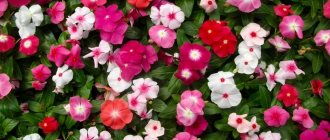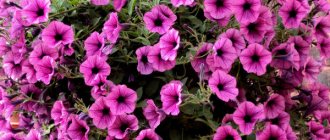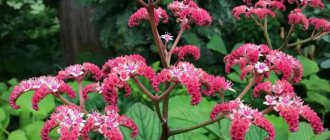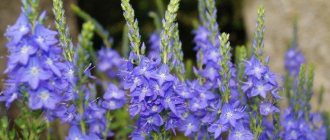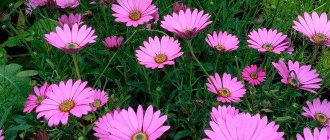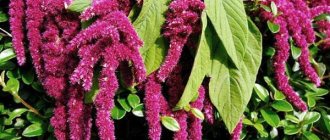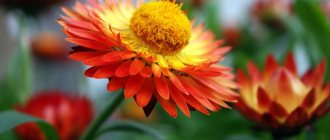Origin and appearance of garden balsams
Garden balsam belongs to the Balsam family, genus Impatiens. From Latin this name is translated as “touchy, untouchable.” The ripe fruits of the plant open when touched, releasing seeds within a radius of 2 meters.
Garden balsam
The genus includes about 500 species. Such diversity and prevalence in many regions of the planet makes it difficult to accurately determine the homeland of the flower. Most often, balsams grow in tropical and temperate climates.
Note! The main growing areas are Europe, North America, Asia, and part of the African continent.
“Untouchable” plants were discovered in the 17th century. Their first descriptions date back to 1869 and concern varieties discovered in India and neighboring areas of Asia. Most of the species were discovered and classified in the 19th century, during the period of active study of remote corners of the planet. The last to be discovered was a group of balsams from New Zealand. This only happened in 1989.
Continuously blooming balsams in Western countries are called Busy Lizzie, and in Russia the flower received the nickname Vanka Mokry. At first glance, it is in no way associated with the plant. Such an unusual name is associated with an interesting feature: drops of sweet liquid form on the leaves of balsam. Gradually they harden and turn into sugar balls.
Initially, in our climate, balsams were grown only at home. But thanks to breeding work, varieties for outdoor use have appeared. This is how garden balsam arose. This is an annual plant, a shrub with fleshy, dense branches, trunk and leaves. They have one peculiarity: not being flexible, they break easily. The height of the bush varies from 20 to 70 cm in different varieties.
Note! In rainy weather or during fog, the plant is relieved of excess moisture in an unusual way: drops of liquid form on its leaves.
Drops of moisture on the leaves of a plant
Outdoor balsam differs from its indoor “brothers”:
| List of professions | Regulatory issuance procedure |
| Builders | signal form; gloves; PPE for face and ears; Vibration reduction products |
| Drivers | mittens; warm suit; safety shoes |
| Loaders | overalls; gloves; jackets; trousers. |
| Sales staff | headscarves; gloves; robes |
| Agricultural employees | gloves; shoes; mittens. |
| Electrical workers | dielectric special gloves; safety shoes; headdress; outerwear; thermal underwear for dielectrics. |
Important! Perennial garden balsams are not found. The species growing in flower beds are annual balsams.
Description of balsam flowering
Buds and flowers form at the base of the leaves. Flowers have different sizes and shapes, depending on the variety. Petal color options range from white to dark burgundy. The most common are pink and purple. Hybrids may have double petals.
Important! Garden balsams do not have blue or yellow petals.
Flowering in open ground covers almost the entire growing season, it occurs from May to the end of September.
Diseases and pests, control methods
Parasitic insects and mites settle on Vanka Mokroy:
| Types of pests | Causes | Fighting methods |
| Aphid | Improper implementation of agrotechnical measures, abundance of garden ants protecting aphids | Treatment of leaves on both sides, stems, flowers with tobacco dust. Planting balsam near the beds where vegetables from the umbrella family grow: natural enemies of aphids often live there: ground beetles, ladybugs |
| Spider mite | Soil drying out, heat, moisture deficiency | Spray the bushes more often in the evenings, lightly shade them to protect them from the scorching sun, and moisten the soil in time. Treat with a solution of laundry soap, spray with acaricides (anti-tick products): Sunmite, Fitoverm, Apollo, Actellik, Anti-tick. Fitoverm is the least toxic product, other drugs are hazard classes 2 and 3, it is important to protect the face, hands, eyesight and respiratory organs |
| Whitefly | The weather is warm, there is a lot of moisture in the air, the plantings are very thick. The bushes are weak, fertilizing is carried out in violation of the deadlines | To catch insects, hang sticky traps and treat them with insecticides every 7 days. |
Another useful table with data on balsam diseases:
| Diseases | Reasons for development | How to treat a plant |
| Gray rot, powdery mildew | Increased air and soil humidity, excessive watering | Remove the infected specimen(s), if the affected area is small, cut off the diseased shoot, treat the cut with charcoal powder. Copper sulfate and fungicides (antifungal drugs) give a good effect: Barrier, Barrier, Fundazol |
| Bacteriosis, mosaic virus | Movement of pathogens from neighboring plants, more often vegetable crops. Viruses infect weak plants if agricultural practices are not followed | The underground and above-ground parts are removed so that the diseases do not spread to neighboring bushes. It is important to find out what rules the grower is violating and adjust the care of tropical specimens |
Types and varieties of balsam for growing outdoors
Krinum - garden flower, planting and care in open ground
Most varieties of garden balsam were bred in Europe; they are not so numerous. Plants vary in flower color, structure, and shape. There are specimens similar to camellias, roses, and carnations.
Tom Thumb
Compact, dense bushes with a height of 25 to 40 cm. The variety is distinguished by the variety of shades of petals and the duration of flowering. The flowers are double, cover the bushes in large quantities in June and remain, replacing each other until September. And if the air temperature allows, then Tom Thumb blooms until mid-October. Prefers slightly shaded areas, light fertile soils. In such conditions it produces the most magnificent and abundant flowering. It is easy to care for.
Variety Tom Thumb
Balsam Ironbearing
The name “iron-bearing” is explained by the presence of special glands, dense compounds that are located at the base of the leaf plates. The annual shoots are smooth, reaching 50 cm in height. The leaves are bright green, oval, about 15 cm. The flowers are attached to long peduncles. Their color can be pink, bright red, or wine shades.
Important! The disadvantage of this variety is that over time it can turn into a weed.
Hawker's Balsam
The natural habitat of this species is New Guinea, Solomon Islands. It was discovered by botanists in 1884. Wild forms have not taken root as an ornamental crop on the European continent. However, on their basis, large-scale work was carried out to develop hybrid varieties.
A distinctive feature of Hawker's balsam is its large flowers of a beautiful purple hue with a whitish core. The leaves are ellipsoid, green, with beige veins.
Impatiens grandiflora
The birthplace of the species is Sri Lanka. Valued by gardeners, it is becoming increasingly popular due to its large flowers. Their diameter reaches 6 cm. And the color can be different: white, pink, deep red, salmon, purple. Varieties with two-color colors have also been bred. Due to the fact that new buds are constantly forming and blooming, the effect of long-term flowering occurs. It ends only with the onset of frost.
The plant is bushy, densely covered with foliage. Its height and diameter are about 30 cm. The leaf blades are dark green, with a jagged edge. They are practically hidden by a large number of flowers.
Large-flowered balsam
Impatiens creeping
One of the shortest varieties. Miniature plants have an unusual stem color - reddish-brown. The golden hue of the petals looks contrasting against its background. In Russia, this plant still remains very rare.
Impatiens impatiens
A well-known species native to Bengal. In this region, the plant is grown not so much for decorative purposes, but as a seasoning for food. This is a herbaceous annual with a straight stem 25-45 cm high, lanceolate narrow leaf blades with a serrated edge.
The flowers are large, located on short stalks, several in each leaf axil. The diameter of the flowers is about 3 cm, and the color is pink or purple-white. Some varieties have double petals.
Note! The fruits are pubescent, egg-shaped capsules. Flowering period is from July to August. The fruits ripen in September.
Balsam Camellia
The Camellia variety got its name from the similarity of the shape of the flowers to real camellias. Their shades range from purple to snow-white. The bush is covered with many leaves and flowers arranged in pairs. Their size is about 5 cm.
The Camellia variety is very thermophilic and does not survive at low temperatures. Before planting in open ground, seedlings are germinated in good lighting conditions. Without light, plants produce arrows. Flowering occurs at the end of June.
Balsam Carmelita
The stems of the Carmelita variety rise 70 cm above the ground. The plants have a pyramidal shape. The stems are fleshy but fragile and break at the nodes, so they are protected from strong winds. The flowers are double, up to 4 cm in size. Their shape is camellia-shaped, and their color ranges from purple to white. The first buds open in June. Flowering does not stop until September.
The variety is very thermophilic and responds to any temperature changes. Seedlings are planted in open ground in late May - early June.
Variety Carmelita
Balsam Fashionista
The highlight of the variety is its contrasting color. Its two-tone, hot pink and white camellia-shaped double petals do not go unnoticed in the flowerbed. They bloom in the axils of each leaf. The plant itself is erect, 40-50 cm high. It flowers very profusely. In order for the bush to acquire a beautiful shape, it is pinched.
The flower is photophilous and heat-loving, but can grow in slight shade. Loves fertile light soil. Can remain fresh for a long time when cut.
There are other types: Waller's balsam, New Guinea, terry, impatiens small-flowered.
Planting balsam seedlings in open ground
The best time to plant garden balsam in open ground is May. By this month, in most regions, the threat of spring frosts, which can destroy seedlings, has passed.
What is needed for planting
Crocosmia - planting and care in open ground
Before planting seedlings in open ground, it is necessary to prepare the soil. Plants prefer loose, fertile, non-acidic soil.
Important! You can determine the acidity of the soil at home using an infusion of currant leaves. If, when adding a small amount of soil to it, it turns reddish, the soil is acidic. If the solution turns blue, it is slightly acidic, and if it turns greenish, it is neutral.
The holes for seedlings should be the same size as the containers with seedlings, so that when planting the root collars of the seedlings are not buried. A small amount of vermicompost is poured into the bottom of each hole.
The soil can be shed in advance with a fungicide, fed with stale manure, and moistened.
Choosing the optimal location
Impatiens need protection from strong winds and direct sunlight, because of which it begins to wither and curl the leaves. Flowers are often planted along fences, near trees. You can also successfully grow them in garden boxes and flowerpots.
Experienced gardeners have noticed that plants feel best on the western and eastern sides of the site. In flower beds, balsams are combined with any variety. But the best neighbors for impatiens are begonias, fuchsias, and verbena.
Transplanting
Step by step planting process
To determine whether the plant will take root in open ground and whether it will develop quickly, it is removed from the container for germination and the condition of the root system is assessed; if the earthen ball is riddled with white roots, the seedling is transplanted outside. Planting stages:
- Plants, together with a lump of earth, are laid out in holes.
- They are made at a distance of 25-30 cm from each other, since garden balsam bushes grow quickly.
- Sprinkle the soil and press lightly.
- Carry out abundant watering.
Plantings are mulched with sawdust. This prevents the soil from drying out and the roots from being washed away when watering, and also provides air access to the root system and inhibits the growth of weeds.
Algorithm of actions at home
Balsam transplantation is carried out as follows:
Before upcoming events (a day before), thoroughly water the soil.- Carefully remove the plant from the old container.
- Shake all the roots off the ground and assess their condition. Remove all dry, rotten, old and heavily entangled roots using a sharp knife.
- Disinfect the cut areas and sprinkle with wood ash or crushed activated carbon.
- Place the substrate at the bottom of the new pot and carefully place the plant in it, straightening the root system.
- Pay attention to the location of the root collar. It should not be covered with soil. Leave it above the surface of the soil, but a few centimeters below the edge of the container.
- Fill the soil to the required level and compact it lightly.
- Carefully water the newly transplanted flower and place it in the shade for rooting and acclimatization for 3-5 days.
Advice . If you choose a wider pot, you can plant several balsams in it at once. At the same time, you can get an original and elegant composition if you use plants with inflorescences of different colors.
Watch the video on how to transplant several balsams into one pot.
Balsam propagation
Impatiens are easy to propagate. To create their own collections, gardeners not only stock up on seeds, but also share cuttings. Both methods give good results.
Propagation by cuttings
Hydrangea blue or blue - planting and care in open ground
The longest shoots are selected for harvesting cuttings. The tops are cut off with a sharp knife or blade. The length of the cuttings should be 10-12 cm. The lower leaves are removed from them. Roots subsequently form on the bare nodes.
Note! The lower parts of the cuttings are immersed in water at room temperature. After 10 days, roots will form. Plants can be planted in the ground.
Growing from seeds
Seeds for germination are purchased in specialized stores or collected from flowering plants. This method of reproduction has several disadvantages:
- hybrids do not always inherit the properties of their mother specimens;
- seeds collected from unripe fruit capsules have low germination.
To grow a flower from seeds, the following soil compositions are suitable:
- perlite, compost, humus, turf in equal quantities;
- peat with sand, leaf soil in proportions 1:2.
Balsam Tom Thumb from seeds
Seeds for seedlings are sown in February - early March. Stages of work:
- The seeds are soaked for 10 minutes in a weak solution of potassium permanganate, then left in warm water for 30 minutes.
- The soil in the planting container is moistened.
- Seeds are sown at a distance of 4-5 mm. Sprinkle a thin layer of sand on top.
- The container is covered with film or glass to maintain humidity.
- Provides a temperature range of +24-260 C.
- The plantings are ventilated daily. Seedlings are hardened off to make the plants resistant to disease.
- After the first shoots appear, additional lighting is provided so that the shoots do not stretch.
- The soil is moistened as necessary.
- After the appearance of the third true leaf, the seedlings are planted.
Self-collection of seeds
If you decide to propagate balsam by seed, then you can try to prepare the seed yourself. It is worth noting that ripe seed pods can burst even at the slightest touch, after which the seeds will scatter in all directions. Experienced gardeners recommend spraying the plant with water first. When wet, the seed pods are carefully torn off the stems. After this, all that remains is to dry the seed in a paper bag.
Caring for balsam in the flowerbed
Many gardeners are happy to plant balsams in their plots; cultivation and care require a minimum of time and effort. Care consists of regular watering and fertilizing.
Watering mode
Water the impatiens abundantly. The stream of water is directed exactly under the bush so that moisture does not fall on the buds and flowers. For irrigation use settled water.
Note! In hot, dry weather, plants are sprayed with a spray bottle. They do this so that moisture only gets on the leaves. Spraying is carried out twice a day, morning and evening. After watering, it is recommended to loosen the soil.
Fertilizing for lush flowering
Fertilizers are applied twice a week, along with watering. Young plants are fed with nitrogen compounds. They contribute to the growth of green mass. For lush flowering, mixtures with phosphorus and potassium are suitable. At the end of summer, feeding is stopped.
The bright flowering of balsams in the garden opens up wide opportunities for creating spectacular flower beds, borders, lawns, and flowerpots. The variety of colors and shapes allows you to find a worthy use for the annual plant in the country.
How to care in the coming weeks?
Watering
A time interval of 2 days must be observed between waterings. The top layer should not dry out completely . Otherwise, the flower will begin to wither and wither.
But stagnation of water in the pan will have a bad effect on the plant. So 3-4 hours after watering it needs to be poured out. Otherwise, this is fraught with insect attack and the development of fungal diseases. Use soft, settled water for irrigation.
Humidity
During flowering, spray balsam if the temperature is above 21-22 degrees . Liquid getting on the inflorescences is unacceptable, otherwise it will lead to the development of unsightly spots on the delicate petals.
Place an open container of water near the plant during its flowering. This will maintain optimal air humidity.
Top dressing
Add fertilizer to water for irrigation and apply every 2 weeks throughout the flowering period . At this time, the plant will expend a lot of energy, so it needs to be provided with additional nutrition.
Important! Liquid mineral fertilizers intended for flowering plants will help compensate for the lack of necessary substances. You can buy them at any garden store.
Read about how to feed balsam for abundant flowering and how to water it properly in this material.
Diseases and pests
Garden balsam is susceptible to the following diseases and pests:
Cucumber mosaic .
The leaves are damaged, their growth stops, they become wavy and covered with yellow spots. Tear off the affected leaves. As a preventive measure, active control of aphids, which are carriers of the virus, is used.
Ring mosaic .
The leaves begin to become woody, crack and become covered with spots that look like ring fingerprints. The plant gradually withers and dies. Affected leaves should be removed immediately.
Bronzing .
The growth of leaves is inhibited, which leads to their deformation. As a result, they shrink and fall off. Plants affected by the virus cannot be saved; they must be disposed of, otherwise the disease can spread to other plants.
Viral mosaic .
The foliage becomes covered with yellow spots and becomes wavy. For prevention, treat the plant with a product against thrips and aphids (Decis Expert, Confidor), which spread the virus.
Spider mite .
This insect weaves its web on the inside of the leaves, and then it eats them. For prevention, treat with a soap solution (1 liter of water and 40 g of soap). Remove affected leaves.

